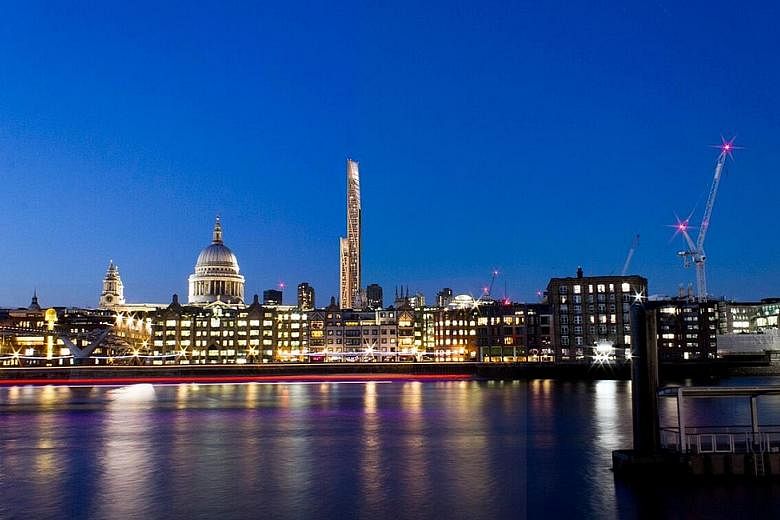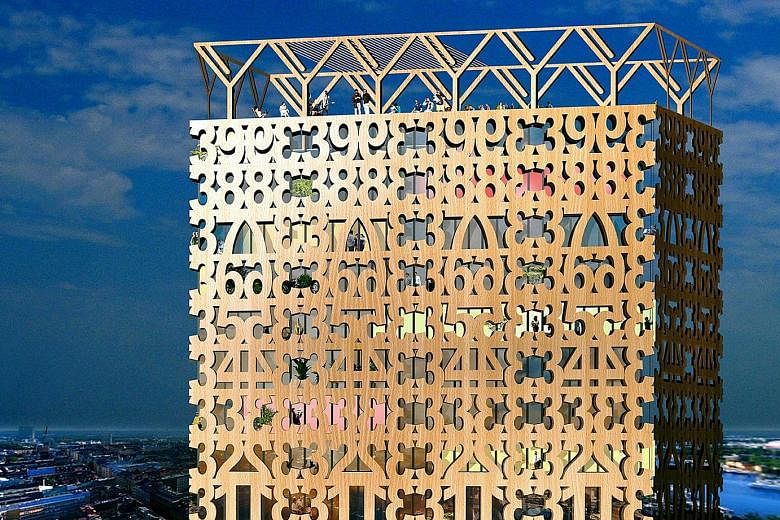NEW YORK • At a newly renovated plant in Riddle, Oregon, workers glue together boards harvested from nearby forests, where Douglas fir has grown for thousands of years, and feed the resulting 3m-by-9m panels into a pneumatic press. What comes out three hours later, their boss is convinced, is the building material of the future.
Proponents of the material, called cross-laminated timber or CLT, say it can be used to erect buildings that are just as strong and fire-resistant as those made from steel and concrete.
Those qualities have helped excite the passions of architects and environmentalists, who think it could unlock a greener method for housing the world's growing population, and timber producers, who hope to open an American market for the value-added good.
"We see a horizon that's very promising out there," said Ms Valerie Johnson who, with her sister and mother, owns D.R. Johnson Wood Innovations.
Mass timber construction, which uses CLT and other engineered wood products, was pioneered in Europe in the 1990s to replace concrete blocks in the construction of single-family homes and it has slowly gained popularity.
Wood sequesters carbon from the environment, while producing concrete emits carbon, exacerbating global warming. The system for building with CLT, Ms Johnson said, involves assembling pre-fabricated parts, speeding construction and paring labour costs. Those attributes have sparked a race to build the world's tallest wood building.
Recently proposed structures include a 100-storey tower in London, nicknamed the Splinter, and a 40-storey building in Stockholm. A number of wood buildings in Australia, Norway and Britain have jockeyed for the title of tallest wood building in recent years, all topping 10 storeys.
Interest is spreading from Europe to North America.
In 2013, Vancouver-based architect Michael Green proselytised for the material in a TED Talk on the subject that has been viewed more than a million times.
The same year, SOM, the Chicago architecture firm that designed the world's tallest building, published a white paper outlining techniques for building a 42-storey wood building.
Last year, the United States Department of Agriculture awarded a pair of grants to fund work on tall wooden buildings in New York and Portland, Oregon.
Over the longer term, mass timber proponents will have to answer a laundry list of questions, including whether people really want to live and work in tall wood buildings and whether trees used to make the material can be sustainably harvested.
"It's going to take some time to build up the infrastructure here to compete with materials already being used," said Dr Thomas Maness, dean of the College of Forestry at Oregon State University.
Still, if mass timber gains traction in the US, Ms Johnson will be well positioned.
For the past 50 years, D.R. Johnson has made glue-laminated beams, industry-speak for what you get when you join two-by-fours into solid columns. The biggest beams the company has made are 2.75m-wide, 42.7m-tall posts custom-built as utility poles used by the fracking industry in North Dakota.
That experience gave the company a head start on producing CLT, though it still needed to hone new techniques and buy new equipment.
Ms Johnson invested in a custom- built panel press at the end of 2014 and produced wall and floor panels for the company's first project, a four-storey building that went up in Portland in February.
"If you look at the architecture, engineering or construction industry, there are a few pioneers in every field and those are the people we're working with," she said.
"It's been a once-in-a-career opportunity to be out in front of something."
BLOOMBERG


